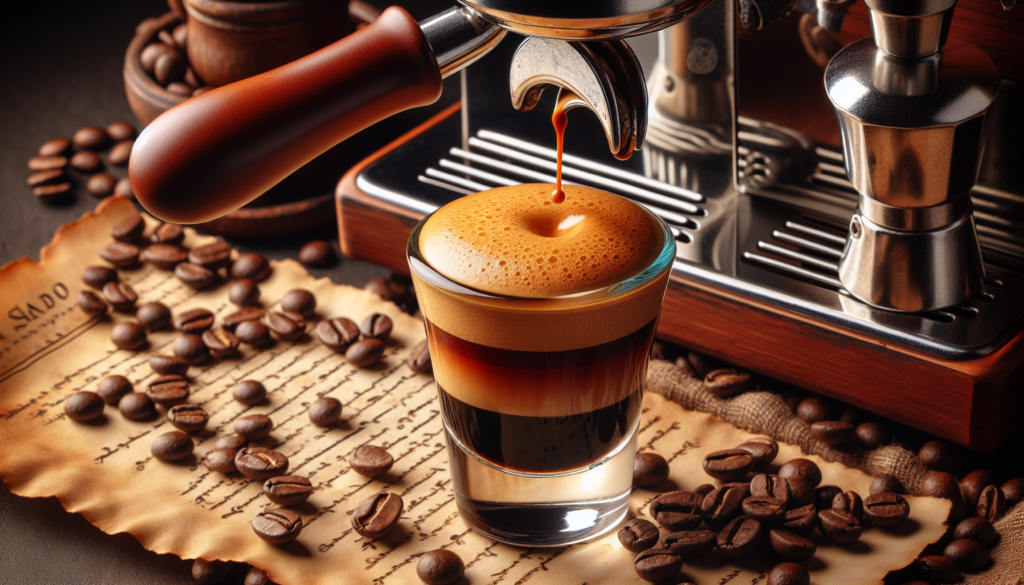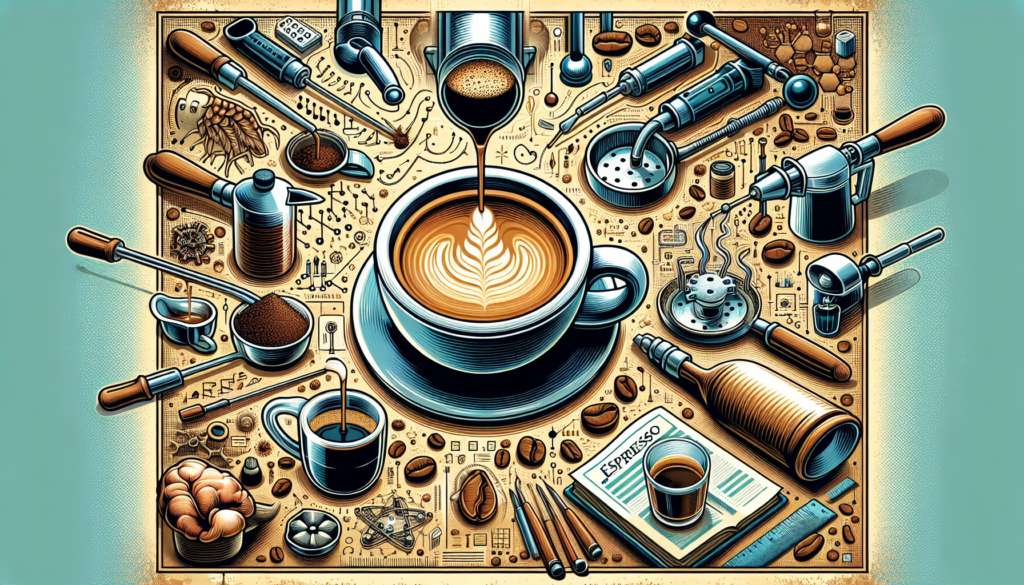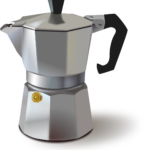So you think you know everything there is to know about espresso? Well, think again! Believe it or not, there’s more to this beloved, bold beverage than meets the eye. Many people assume that espresso is simply a combination of coffee and water, but the truth is, it’s a whole lot more complex than that. In fact, the process of making espresso involves a delicate balance of pressure, temperature, and extraction time. So, if you’ve ever wondered what sets espresso apart from your regular cup of joe, stick around as we uncover the fascinating world of this concentrated, rich delight.

The Origins of Espresso
The Discovery of Espresso
The origins of espresso can be traced back to Italy in the late 19th century. The exact details of its discovery are often debated, but one popular story involves Luigi Bezzera, an Italian inventor. In the early 1900s, Bezzera found a way to speed up the brewing process by forcing hot water through coffee grounds under high pressure. This method resulted in a concentrated and flavorful coffee that became known as espresso.
The Birth of the Espresso Machine
Following the discovery of espresso, various inventors and engineers began experimenting with different designs to create a machine specifically for brewing this new type of coffee. One significant breakthrough came in 1947 when Achille Gaggia invented the first modern espresso machine that used a piston to create pressure and produce a rich layer of crema on top of the espresso shot. This invention revolutionized the espresso industry and paved the way for the popularity of espresso worldwide.
The Basics of Espresso
Ingredients of Espresso
At its core, espresso is made up of only two ingredients: coffee and water. The coffee used for espresso is typically a dark roasted blend that is finely ground. The type of coffee beans used can vary, but popular choices include Arabica and Robusta. The water should be filtered and heated to around 195-205 degrees Fahrenheit (90-96 degrees Celsius).
The Brewing Process
Brewing espresso involves several key steps. Firstly, the espresso machine is preheated to ensure the water reaches the optimal temperature. Then, the finely ground coffee is dosed into a portafilter and evenly distributed. This step is crucial to ensure an even extraction. The coffee grounds must then be tamped firmly to create resistance and a uniform surface.
Once the preparation is complete, the portafilter is locked into the espresso machine, and the brewing process begins. The machine forces hot water under high pressure through the tamped coffee grounds. This process typically takes around 25-30 seconds, and the result is a small, concentrated shot of espresso with a layer of crema on top.
The Difference Between Espresso and Regular Coffee
Coffee-to-Water Ratio
One fundamental difference between espresso and regular coffee lies in the coffee-to-water ratio. While regular coffee typically uses a ratio of around 1:15 (one part coffee to fifteen parts water), espresso requires a much higher concentration. The coffee-to-water ratio for espresso is around 1:2, resulting in a stronger and more intense flavor profile.
Grind Size
Another distinction between espresso and regular coffee is the grind size. Regular coffee is commonly brewed with coarser grounds, while espresso requires a much finer grind. The fine texture allows for better extraction when water is forced through the coffee grounds under high pressure. This finer grind size ensures that the water passes through the coffee bed evenly, resulting in a balanced and full-bodied espresso shot.
Brewing Time
The brewing time also sets espresso apart from regular coffee. A typical cup of filtered coffee may take a few minutes to brew, while an espresso shot is extracted in a matter of seconds. The short brewing time allows for a quick extraction of flavors and the retention of vibrant acidity and aroma in the final product.
Exploring the Espresso Shot
The Crema
One defining characteristic of espresso is its rich and velvety crema. The crema is the light tan-colored layer that forms on top of a properly brewed espresso shot. It is created by the emulsification of coffee oils with carbon dioxide and water, resulting in a thick and flavorful foam. The presence of crema not only adds visual appeal to the espresso shot but also contributes to its smooth texture and complex taste.
Body and Flavor
Espresso is known for its bold and concentrated flavor profile. The high pressure and short extraction time allow for the extraction of oils, acids, and sugars, producing a full-bodied and intense taste. The flavor profile can vary depending on the coffee beans used, with notes of chocolate, caramel, fruit, or nuts commonly present in a well-brewed espresso shot.
Caffeine Content
Contrary to popular belief, espresso does not necessarily have more caffeine than regular coffee. While the concentration of caffeine per ounce is higher in espresso due to its smaller serving size, a typical 2-ounce (60 ml) shot of espresso contains approximately 63 milligrams of caffeine, whereas an 8-ounce (240 ml) cup of regular coffee contains around 95 milligrams of caffeine. However, due to its stronger flavor, espresso may give the perception of a higher caffeine content.

The Role of Pressure in Espresso
The Importance of Pressure
Pressure plays a crucial role in the brewing process of espresso. The high pressure created by the espresso machine extracts flavors and compounds from the coffee grounds quickly and efficiently. The optimal pressure range for espresso extraction is typically between 9 and 10 bars, although some modern machines can go up to 15 bars. This pressure forces hot water through the tightly packed coffee grounds, resulting in the desirable characteristics of a well-brewed espresso shot.
Traditional versus Modern Espresso Machines
Traditional espresso machines, such as those pioneered by Gaggia, use a lever or manual operation to create pressure during extraction. These machines require skill and precision from the barista to maintain consistent pressure throughout the brewing process.
However, modern espresso machines are often equipped with more advanced and automated systems. They use electric pumps to generate and control pressure, providing more consistent results and making it easier for baristas to achieve optimal extraction.
The Shot Varieties in the Espresso World
Single Shot
A single shot of espresso typically refers to a 1-ounce (30 ml) serving. It is the standard measurement for a traditional espresso shot and forms the base for various espresso-based drinks.
Double Shot
A double shot of espresso, also known as doppio, is twice the volume of a single shot, usually around 2 ounces (60 ml). The double shot is popular in coffee shops and often serves as a base for stronger and larger drinks like lattes and cappuccinos.
Ristretto
Ristretto is an espresso shot made with the same amount of coffee grounds but extracted with half the amount of water. It results in a highly concentrated and intense flavor. Ristretto shots are known for their rich body and robust taste.
Lungo
Lungo is the opposite of ristretto. It is a “long” shot of espresso made with the same amount of coffee grounds but extracted with double the amount of water. The resulting shot is milder in flavor but has a larger volume, typically around 3 ounces (90 ml).
The Art of Tamping
Tamping 101
Tamping is a crucial step in the espresso brewing process. It refers to the act of pressing the coffee grounds firmly and evenly into the portafilter before brewing. Tamping ensures proper extraction by creating a uniform surface for the water to pass through and preventing channeling, which can result in under-extraction.
A tamper, typically made of metal or wood, is used to apply downward pressure onto the coffee grounds. The tamping process should be done consistently, using the correct amount of pressure and maintaining a level surface. Proper tamping technique is essential for achieving balanced extraction and optimal flavor.
Factors Affecting Tamping
Several factors can affect the tamping process and ultimately impact the quality of the espresso shot. One crucial factor is the grind size of the coffee. Finer grind sizes require less pressure during tamping, while coarser grind sizes may need more pressure to create a solid and even coffee bed.
Another factor is the coffee distribution within the portafilter. Uneven distribution can lead to uneven extraction and an imbalanced shot. It is important to ensure that the coffee grounds are evenly spread and distributed before tamping.
Latte, Cappuccino, and Other Espresso-Based Drinks
The Introduction of Milk
While espresso can be enjoyed on its own, it also serves as the base for various espresso-based drinks. One significant development in the world of espresso was the introduction of milk into these coffee creations. The addition of milk not only enhances the flavor profile but also brings a unique texture and creates a whole new range of possibilities for coffee lovers.
Popular Espresso-Based Drinks
• Latte: A latte consists of a shot of espresso combined with steamed milk and a small layer of foam on top. It is a milkier, milder option that allows the flavor of the espresso to blend harmoniously with the creamy milk.
• Cappuccino: A cappuccino is made with equal parts of espresso, steamed milk, and milk foam. The layers of espresso, milk, and foam create a visually appealing drink with a balanced flavor profile.
• Macchiato: A macchiato is an espresso shot “stained” with a small amount of milk. It has a stronger coffee taste compared to lattes or cappuccinos but still offers a hint of creaminess.
• Americano: An Americano is made by diluting a shot of espresso with hot water. It produces a milder and less concentrated drink compared to a straight espresso shot.
These are just a few examples of the countless variations and combinations that can be created using espresso as a base. The world of espresso-based drinks is constantly evolving, with new flavors, ingredients, and techniques being introduced by creative baristas and coffee enthusiasts.
Espresso Quality and the Specialty Coffee Movement
Understanding Specialty Coffee
The concept of specialty coffee focuses on producing high-quality beans with unique flavor profiles and exceptional characteristics. Specialty coffee is typically produced in specific regions, often at higher altitudes, where the cultivation and processing methods are carefully monitored and controlled.
These beans undergo rigorous quality assessments by professionals known as Q Graders. The Q Graders evaluate factors such as taste, aroma, acidity, body, and balance to determine if the coffee meets the specialty coffee standards. Specialty coffee aims to offer a distinct and superior coffee experience to consumers who appreciate the complexities and nuances of a well-crafted cup of coffee.
Certifications and Quality Control
To ensure the authenticity and quality of specialty coffee, various certifications and quality control measures have been established. Organizations like the Specialty Coffee Association (SCA) and Rainforest Alliance set standards and criteria for sustainable and ethical coffee production.
Certifications such as Fair Trade, Organic, and Direct Trade provide consumers with confidence that the coffee they are purchasing meets certain social, environmental, and ethical standards. These certifications also often indicate higher quality and more traceable supply chains, offering transparency and accountability within the coffee industry.
The Third Wave Coffee Movement
The specialty coffee movement gave rise to the “Third Wave Coffee” movement, which emphasizes the artisanal and meticulous approach to coffee production and consumption. Third Wave Coffee focuses on the origin and the intricacies of each coffee bean, highlighting its unique attributes and encouraging a deeper appreciation for the craftsmanship involved in brewing the perfect cup of coffee.
Third Wave Coffee enthusiasts prioritize sustainable sourcing, direct trade relationships with farmers, and precise brewing methods. They believe in celebrating the individuality of each coffee bean, the expertise of the roasters, and the skill of the baristas, ultimately aiming to elevate coffee to the level of a craft beverage.
Experimenting with Espresso
Flavored Espresso
While purists may argue that espresso should be enjoyed in its purest form, there is a growing trend of experimenting with flavored espresso. Flavored syrups, such as vanilla, caramel, or hazelnut, can be added to an espresso shot or used in espresso-based drinks. These added flavors provide a unique twist and allow coffee lovers to tailor their espresso experience to their personal preferences.
It is important to note that the quality of the espresso and the balance between the added flavor and the coffee itself should be maintained. Flavored espresso should enhance, rather than overpower, the natural characteristics of the coffee.
Espresso Cocktails
Espresso also serves as a versatile ingredient in cocktails. Its rich and intense flavor pairs well with a variety of spirits and liqueurs. Espresso martinis, for example, combine vodka, coffee liqueur, and espresso for a delightful and energizing cocktail.
Other popular espresso-based cocktails include the Irish Coffee, which combines espresso with whiskey and brown sugar, and the Espresso Martini, a mix of espresso, vodka, and coffee liqueur. These cocktails showcase the versatility of espresso and its ability to elevate the flavors in a range of alcoholic beverages.
In conclusion, espresso is more than just coffee and water. Its origins, brewing process, and unique characteristics make it a distinct and beloved beverage. Whether enjoyed as a straight shot or as the base for various espresso-based drinks, espresso offers a depth of flavor and richness that continues to captivate coffee enthusiasts around the world. With its rich history and ever-evolving culture, espresso remains a timeless classic in the world of coffee.






